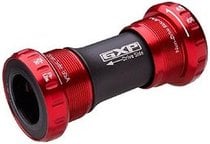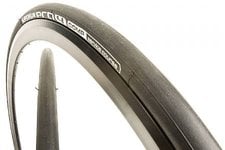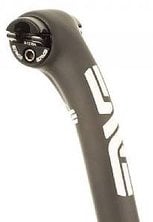Go Faster Now!
As spring rolls in, racing heats up, group rides begin and even that morning coffee ride gets a bit jumpy as the city limits sign comes into sight. Racers are hoping all that winter training will pay off, while group rides among friends become local Spring Classics. As fenders and rain capes return to the closet, team kits and race wheels enter the regular rotation. Many riders look to make a few key equipment upgrades in search of that 2% advantage that can be the difference between making a breakaway or winning that county line sprint and being stuck with the rest of the pack.
Cycling is a unique sport in that buying stuff really can make you better. Basketball players can't buy a better jump shot, runners can't buy shoes that make them go faster, but faster bicycle components can make a difference. Cycling manufacturers know this, and would have you believe saving every gram, aero-this and carbon-fiber-that, is going to make you a better rider. Industry marketing can make it very hard to find the products that will actually benefit your riding.
Our staff of racers here at WesternBikeworks.com have tried just about every weight saving, wind cheating shortcut out there. We've also spent way too much company time reading up on wind tunnel test results, analyzing rolling resistance data, and interpreting our power-meters. Here's a quick guide to what we've found will make your dollar go farthest when buying speed.
Wheels
A good set of race wheels is the single most important factor in the performance of your bike. Race wheels should be stiff, aerodynamic and light. These factors are somewhat mutually exclusive, so it is key to find a balance that suits your riding style.
The first decision to make is clinchers vs. tubulars. To make a long story short, clinchers are more convenient and have actually gained the edge in rolling resistance, while tubulars are lighter and offer a feel that many agree is simply impossible to achieve with clinchers.
There is a reason pro riders almost uniformly choose deep-section carbon rims. Speed at race pace is primarily determined by aerodynamics, and rims with a deep profile have the advantage there. Wheel weight mainly comes into play when accelerating. In most race conditions, the draft from the peloton allows easy acceleration up to race speed. A racer's goal is to go faster than race speed, and aero rims help make that happen.
When it comes to performance, the counterpoint to a deep-section wheel is the minimalist: a less aerodynamic but overall lighter set of wheels. Ultralight wheels will best suit riders who excel on long climbs and recreational riders looking for a faster feeling wheel that's easier to get up to speed. For riders lucky enough to be born with climbing legs, an ultralight wheelset will be noticeably quicker on long, steep climbs. Though climbing efficiency is most often cited as the reason to choose "light" over "aerodynamic," acceleration is also a key factor. The lighter your wheelset, the faster your acceleration. Light wheels also produce a livelier and more comfortable ride than their heavier deep section counterparts. If you're not a racer worrying about efficiency over a 150km course, lighter, shallower-profile wheels will deliver a nice combination of comfort, quick acceleration and Strava KOM climbing weight.
It's also possible to find a happy medium between aerodynamics and light weight. Good all-around racing wheels will be light enough to climb and plenty durable, with enough aerodynamic design details that they won't hold you back in a crit or shorter road race.
Ceramic Bearings
It was only really a matter of time until the trick ceramic materials once reserved only for professional racers began to appear on bikes built for the rest of us. Pro racers have been using ceramic bearings for years. They are lighter and more durable than their steel counterparts, with better structural integrity, and most importantly for the purposes of going faster, they are 4% more efficient than their steel counterparts. That means that for every 100km your competition rides, you've ridden 104km. Sounds like a win to us. One of the real beauties of ceramic bearings is that, unlike most upgrades that save weight, they're actually more durable than conventional bearings. The ceramic used in these bearings is actually hard enough to pulverize dirt and small contaminants, making for a smoother rolling and longer lasting wheel. 
Overall, ceramic bearings represent a genuine performance improvement for wheelsets. Look for wheels with hubs featuring ceramic bearings or consider updating your wheels' existing freehubs with ceramic versions.
Bottom brackets also benefit a great deal from ceramic bearings. Bottom brackets rely on larger bearings and handle a significant amount of load, while also being subject to contamination, so ceramic bearings offer noticeable advantages, including dramatically reduced friction, longer life and considerable weight savings.
Ceramic pulleys for your derailleurs are last on the must-upgrade list. As they don't bear any weight, the performance boost delivered by ceramic derailler pulleys won't be as pronounced as that of the above components. But if you want the smoothest, quietest and most efficient drivetrain possible, don't neglect this detail.
Tires
One of the most subjective equipment choices in the cycling world, tire makes and models inspire fierce devotion from riders. The actual differences between competing tires are not quite as clear as manufacturers would have you believe. Believe us, if any tire really was 10% faster than the competition, frequent flats would be about the best side effect you could expect. When it comes to actual tires capable of surviving a ride, practical differences between brands are actually subtle and are most often based on rider preference.
 Compare Continental and Michelin. Both have a well respected all purpose race tire, the Grand Prix 4000 and the Pro4 Service Course respectively. Each of these tires boasts low rolling resistance, excellent grip, and a lively, supple ride. If you can get a top-10, or win a sprint on one of these tires, you can definitely do it on the other. While each brand touts different characteristics, they both use a silica rubber compound, and they will both deliver optimum performance, usually for many miles (though, by definition, racing tires are always more subject to flats and road hazards than heavier tires). We've found that the most notable difference is ride feel: the GP4000 delivers a smoother feel that seems to isolate more vibrations, while Pro Race has a livelier—some might say rough, some might say responsive—ride.
Compare Continental and Michelin. Both have a well respected all purpose race tire, the Grand Prix 4000 and the Pro4 Service Course respectively. Each of these tires boasts low rolling resistance, excellent grip, and a lively, supple ride. If you can get a top-10, or win a sprint on one of these tires, you can definitely do it on the other. While each brand touts different characteristics, they both use a silica rubber compound, and they will both deliver optimum performance, usually for many miles (though, by definition, racing tires are always more subject to flats and road hazards than heavier tires). We've found that the most notable difference is ride feel: the GP4000 delivers a smoother feel that seems to isolate more vibrations, while Pro Race has a livelier—some might say rough, some might say responsive—ride.
Vittoria is another well respected tire brand, and their tubular tires are on probably half the bikes in the European peloton. If you're into matching grams, you'll notice that their race tires are actually quite a bit heavier than comparable tubular tires from other brands, but ride quality and minimal rolling resistance are large part of their appeal. Just ask the pros—lightweight isn't everything.
Saving Weight
 The pro weight limit of 6.8kg (14.99lbs) has partially dissuaded manufacturers from going completely off the deep end when it comes to bike and component weights, but weight savings continues to be a driving force in performance components. Frames, in particular, are using increasingly aggressive carbon fiber layups to achieve some truly astonishing weights, with most now below 1000g and inching ever closer to 500g. Most performance-driven complete bikes built up with high-level components will clock in well under 17 pounds, with pedals. Once you're anywhere near that UCI weight limit, factors like stiffness and aerodynamics generally have a much more significant effect on performance than grams. That said, it's much easier to ride a lightweight bike up hills, and there are a few areas where saving weight is easy and inexpensive.
The pro weight limit of 6.8kg (14.99lbs) has partially dissuaded manufacturers from going completely off the deep end when it comes to bike and component weights, but weight savings continues to be a driving force in performance components. Frames, in particular, are using increasingly aggressive carbon fiber layups to achieve some truly astonishing weights, with most now below 1000g and inching ever closer to 500g. Most performance-driven complete bikes built up with high-level components will clock in well under 17 pounds, with pedals. Once you're anywhere near that UCI weight limit, factors like stiffness and aerodynamics generally have a much more significant effect on performance than grams. That said, it's much easier to ride a lightweight bike up hills, and there are a few areas where saving weight is easy and inexpensive.
Seatpost - While seatposts serve a very important function, supporting most of your body weight, many are overbuilt for the job. Yes, even that lightweight carbon post probably has a heavy aluminum clamp at the top. Even lightweight posts are built to last. With that in mind choosing a lighter seatpost is often a fairly good way to shave an extra 20g or more. The downside, of course, is that most decent seatposts are already pretty light, so the added benefit is usually small relative to the expense of a carbon fiber post.
Saddle - Pick the lightest saddle you're comfortable on. Emphasis on comfortable. Saddles are a great place to save weight if you can, but comfort is paramount. If you're too uncomfortable to ride, any benefit you might've gotten from the weight savings is going to be cancelled out by the training you're not doing. In general, it's just tough to put out watts when your base of operations isn't right, so always choose a saddle based on shape and personal preference first, then weight.
Drivetrain - There's a reason Dura-Ace, Record and Red groupsets hold a special place in the hearts of cyclists. They are light, strong and (for the most part, given their intended use) reliable. While component weights across high-end and more affordable groupsets may look close on paper, the cumulative effect of a few grams here and a few grams there is significant at the end of the day. 105, Centaur and Rival are all great component groups, but a large part of the appeal of each brand's top product line the weight savings and performance that comes from better materials, greater attention to design and a higher level of manufacturing precision.
Our staff of experienced racers at WesternBikeworks.com can help with any of your race day equipment decisions. Contact us at [email protected] or 1-800-651-4050 with questions regarding your race set-up.





